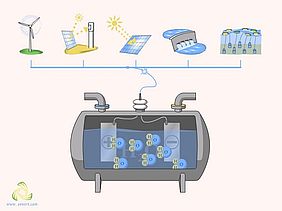Hydrogen energy is generally considered to be one of the cleanest energy sources and shows great potential to become a major player in the energy market as it has high energy conversion efficiency and causes fewer emissions of CO2. It is a highly flammable material that can be used to heat homes, water, and even power engines.
Now (2020), transmission system operators in Germany have created a concept for the establishment of a grid for transporting green hydrogen. This grid could be ready for operation by 2030. The so-called H2 Startnetz was conceptualised by Germany’s gas transmission grid operator umbrella organisation FNB Gas. The proposal includes a network of 1,200 km, using approximately 1,100 km of existing infrastructure, such as converted natural gas pipelines, and only 100 km of newly constructed pipelines. The overall investment will amount to around EUR 660 million. The initial purpose of the grid will mainly consist of connecting key demand areas in the states of North Rhine-Westphalia and Lower Saxony to projects for the production of green hydrogen in the North of the country, including 31 green gas projects. Eventually, it is planned to link the German hydrogen transmission system to the Dutch energy grid. The Netherlands plans to have 30%-50% of its energy produced by decarbonized gas by 2050. Operators believe that this concept could play a major role in helping Germany reach its 2050 climate goals. It would also help industries such as steel and chemicals to become climate neutral.
Similar initiatives have been launched in other parts of the world. In the United States, for example, executives and technical industry experts in hydrogen have formed a collaboration to create a US Hydrogen Road Map across a broad range of applications and sectors. They have developed a base scenario, as well as a more elaborate one for large-scale application of hydrogen. In the base scenario, hydrogen demand would reach 14 million metric tons by 2030 and 20 million metric tons by 2050, representing 1 percent of US final energy demand. The more elaborate scenario includes four key phases, comprising, for example, a successive decarbonization of the country through policies and incentives. Also segments of hydrogen applications would gradually be expanded until hydrogen could be deployed on a large-scale across regions and industries. Concerning distribution, the concept suggests several methods, including pipelines, liquid or gaseous trucking as well as on-site production.
In the United Kingdom, the Gas Goes Green programme is aimed at converting the country’s network of 284,000 km of gas pipelines from delivering methane-based natural gas to zero-carbon hydrogen and biomethane, as well as establishing a new generation of hydrogen-ready boilers in order to reach its climate targets by 2050. Research has shown that developing a zero-carbon gas grid in the UK is possible and may even result in lower energy prices for consumers. Gas network companies have been carrying out trials using hydrogen and other green gas in projects around the country, including at Keele University in Staffordshire, which has launched a project of using hydrogen for heating in homes.
In Australia, Australia’s National Hydrogen Strategy wants to establish the hydrogen industry as a major player by 2030. The strategy involves a comprehensive approach that includes a set of nationally coordinated actions including governments, industry and the community. A key element of Australia’s action plan will be to create hydrogen hubs. These could be located at ports, in cities, or in regional or remote areas. The hubs would ensure more economical development of infrastructure, promote innovation, as well as achieve synergies from sector coupling. Other measures are planned to complement the hubs, such as hydrogen-fuelled transport, industry and gas distribution networks. Also, the strategy provides for the integration of hydrogen technologies into the electricity systems.
There are several advantages to using hydrogen as energy source: hydrogen is a renewable as well as an abundant resource. It can be produced domestically using low-carbon energy systems such as solar power, as well as locally-available technology. This also has the benefit of creating jobs at home rather than in another country. Also, one of the key advantages of hydrogen energy is that it can contribute to reducing CO2 emissions. However, if hydrogen is to be produced in a sustainable and “green” manner, you need to have a developed renewables infrastructure in place, such as wind or solar power.
In order for Germany to become a major player in the hydrogen market, a strong and sustainable domestic market for the distribution and use of hydrogen needs to be established. The H2 Startnetz might be an important step towards achieving this goal.
